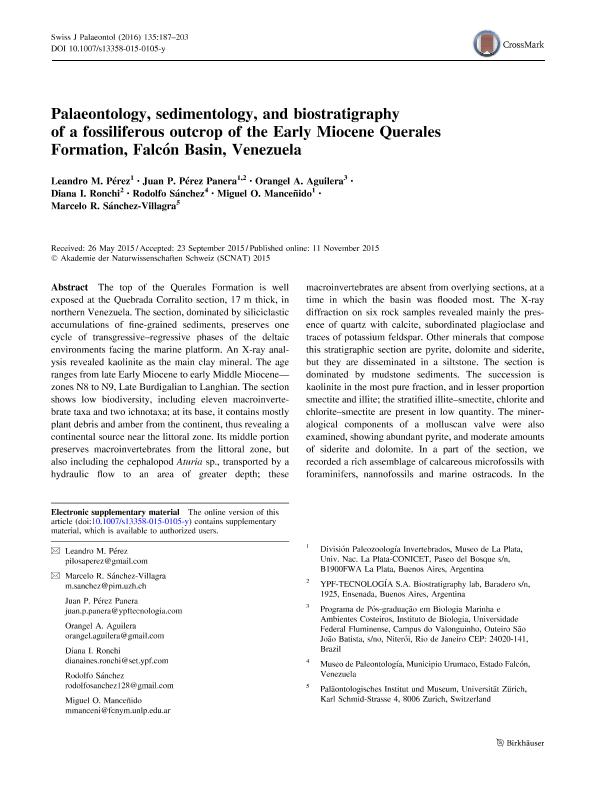Mostrar el registro sencillo del ítem
dc.contributor.author
Pérez, Leandro Martín

dc.contributor.author
Perez Panera, Juan Pablo

dc.contributor.author
Aguilera, Orangel A.
dc.contributor.author
Ronchi, Diana I.
dc.contributor.author
Sánchez, Rodolfo
dc.contributor.author
Manceñido, Miguel Oscar

dc.contributor.author
Sánchez Villagra, Marcelo R.
dc.date.available
2019-02-12T19:45:40Z
dc.date.issued
2016-09
dc.identifier.citation
Pérez, Leandro Martín; Perez Panera, Juan Pablo; Aguilera, Orangel A.; Ronchi, Diana I.; Sánchez, Rodolfo; et al.; Palaeontology, sedimentology, and biostratigraphy of a fossiliferous outcrop of the Early Miocene Querales Formation, Falcón Basin, Venezuela; Springer; Swiss Journal of Palaeontology; 135; 2; 9-2016; 187-203
dc.identifier.issn
1664-2376
dc.identifier.uri
http://hdl.handle.net/11336/69995
dc.description.abstract
The top of the Querales Formation is well exposed at the Quebrada Corralito section, 17 m thick, in northern Venezuela. The section, dominated by siliciclastic accumulations of fine-grained sediments, preserves one cycle of transgressive–regressive phases of the deltaic environments facing the marine platform. An X-ray analysis revealed kaolinite as the main clay mineral. The age ranges from late Early Miocene to early Middle Miocene—zones N8 to N9, Late Burdigalian to Langhian. The section shows low biodiversity, including eleven macroinvertebrate taxa and two ichnotaxa; at its base, it contains mostly plant debris and amber from the continent, thus revealing a continental source near the littoral zone. Its middle portion preserves macroinvertebrates from the littoral zone, but also including the cephalopod Aturia sp., transported by a hydraulic flow to an area of greater depth; these macroinvertebrates are absent from overlying sections, at a time in which the basin was flooded most. The X-ray diffraction on six rock samples revealed mainly the presence of quartz with calcite, subordinated plagioclase and traces of potassium feldspar. Other minerals that compose this stratigraphic section are pyrite, dolomite and siderite, but they are disseminated in a siltstone. The section is dominated by mudstone sediments. The succession is kaolinite in the most pure fraction, and in lesser proportion smectite and illite; the stratified illite–smectite, chlorite and chlorite–smectite are present in low quantity. The mineralogical components of a molluscan valve were also examined, showing abundant pyrite, and moderate amounts of siderite and dolomite. In a part of the section, we recorded a rich assemblage of calcareous microfossils with foraminifers, nannofossils and marine ostracods. In the foraminiferal assemblage, 99 % correspond to planktonic forms. Most macroinvertebrates from benthonic assemblages suggest that they may have inhabited a near-shore marine environment, and sporadically experienced storm transport to deeper, shelf waters.
dc.format
application/pdf
dc.language.iso
eng
dc.publisher
Springer

dc.rights
info:eu-repo/semantics/openAccess
dc.rights.uri
https://creativecommons.org/licenses/by/2.5/ar/
dc.subject
Amber
dc.subject
Calcareous Microfossils
dc.subject
Falcón Basin
dc.subject
Fossil Macroinvertebrates
dc.subject
Neogene
dc.subject
Urumaco
dc.subject.classification
Paleontología

dc.subject.classification
Ciencias de la Tierra y relacionadas con el Medio Ambiente

dc.subject.classification
CIENCIAS NATURALES Y EXACTAS

dc.title
Palaeontology, sedimentology, and biostratigraphy of a fossiliferous outcrop of the Early Miocene Querales Formation, Falcón Basin, Venezuela
dc.type
info:eu-repo/semantics/article
dc.type
info:ar-repo/semantics/artículo
dc.type
info:eu-repo/semantics/publishedVersion
dc.date.updated
2019-02-12T13:23:15Z
dc.identifier.eissn
1664-2384
dc.journal.volume
135
dc.journal.number
2
dc.journal.pagination
187-203
dc.journal.pais
Suiza

dc.description.fil
Fil: Pérez, Leandro Martín. Universidad Nacional de La Plata. Facultad de Ciencias Naturales y Museo. División Paleozoología Invertebrados; Argentina. Consejo Nacional de Investigaciones Científicas y Técnicas; Argentina
dc.description.fil
Fil: Perez Panera, Juan Pablo. Universidad Nacional de La Plata. Facultad de Ciencias Naturales y Museo. División Paleozoología Invertebrados; Argentina. YPF - Tecnología; Argentina. Consejo Nacional de Investigaciones Científicas y Técnicas; Argentina
dc.description.fil
Fil: Aguilera, Orangel A.. Universidade Federal Fluminense; Brasil
dc.description.fil
Fil: Ronchi, Diana I.. YPF - Tecnología; Argentina
dc.description.fil
Fil: Sánchez, Rodolfo. Municipio de Urumaco. Museo de Paleontología; Venezuela
dc.description.fil
Fil: Manceñido, Miguel Oscar. Universidad Nacional de La Plata. Facultad de Ciencias Naturales y Museo. División Paleozoología Invertebrados; Argentina. Consejo Nacional de Investigaciones Científicas y Técnicas; Argentina
dc.description.fil
Fil: Sánchez Villagra, Marcelo R.. Universitat Zurich; Suiza
dc.journal.title
Swiss Journal of Palaeontology
dc.relation.alternativeid
info:eu-repo/semantics/altIdentifier/doi/http://dx.doi.org/10.1007/s13358-015-0105-y
dc.relation.alternativeid
info:eu-repo/semantics/altIdentifier/url/https://link.springer.com/article/10.1007%2Fs13358-015-0105-y
Archivos asociados
